Mormon Trails
Pioneer Pathways to Zion, 1846–1890
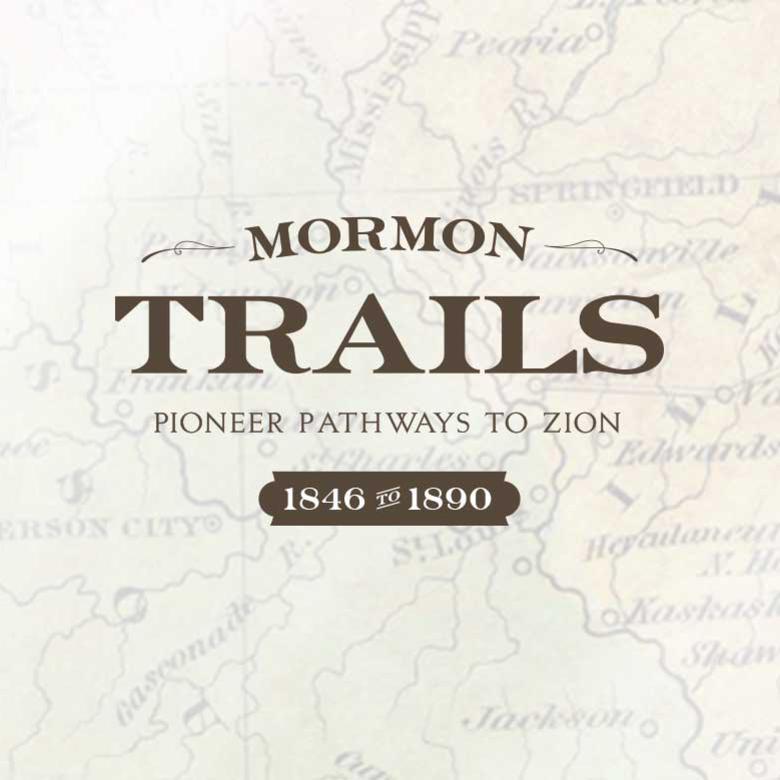

Into the Wilderness, 1846
Beginning in 1846, tens of thousands of Latter-day Saints left homes, friends, and families and endured the rigors of travel by ship, wagon, handcart, and train to gather with fellow Saints in the Rocky Mountains of North America. An exhibit in the Church History Museum in Salt Lake City, Utah, highlights their efforts of faith and commitment through objects they brought with them between 1846 and 1890. This online version supplements the museum’s exhibit with additional artifacts and monuments on display at Church historic sites from Nauvoo, Illinois, to San Diego, California.
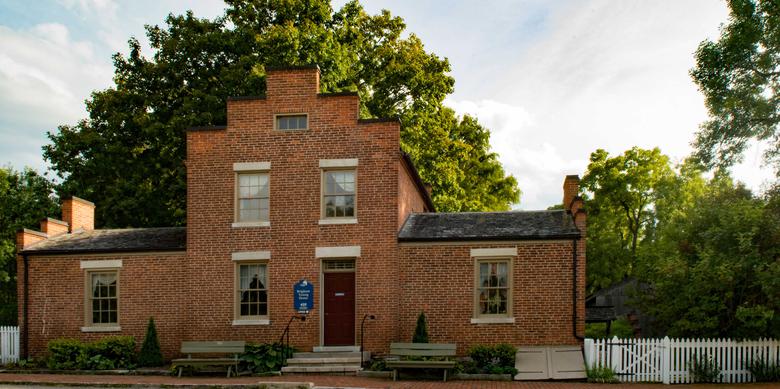
Brigham Young led the Camp of Israel out of Illinois in the snows of February 1846. These 2,500 Latter-day Saints journeyed 300 miles across Iowa Territory. Deep mud and swollen streams slowed their progress. They arrived at the Missouri River in May, too late to continue farther west.
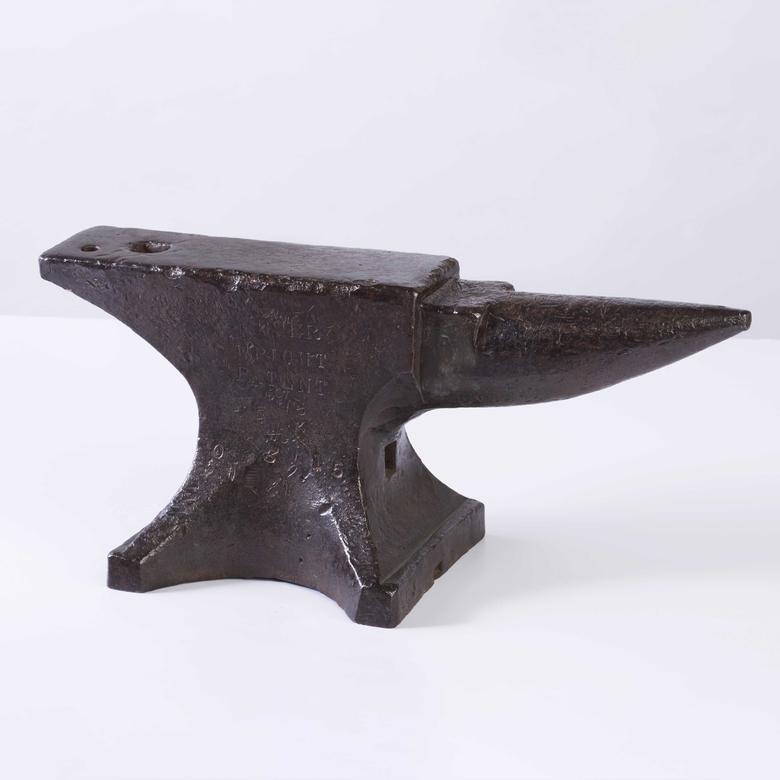
About 700 Saints remained in Nauvoo, many of them ill and without means to travel. Mobs forced them out of the city in September 1846. Rescue teams returned east to help them rejoin the Saints at Garden Grove, Mount Pisgah, and other settlements across Iowa.
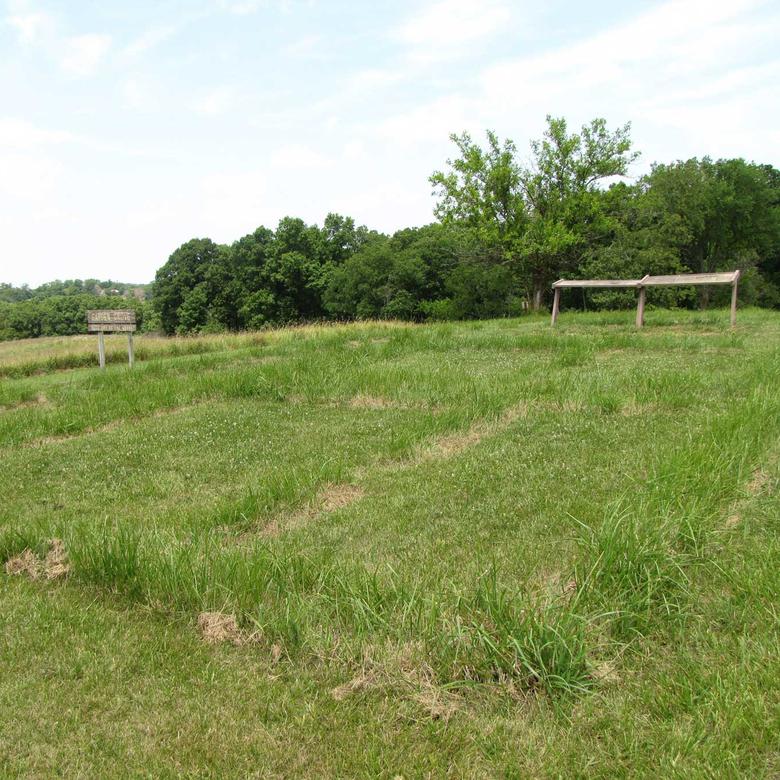
Winter Quarters was the principal settlement for Latter-day Saints who gathered along the Missouri River in 1846. After 1847, Kanesville (present-day Council Bluffs) became the local headquarters for almost 90 Mormon settlements in the area.
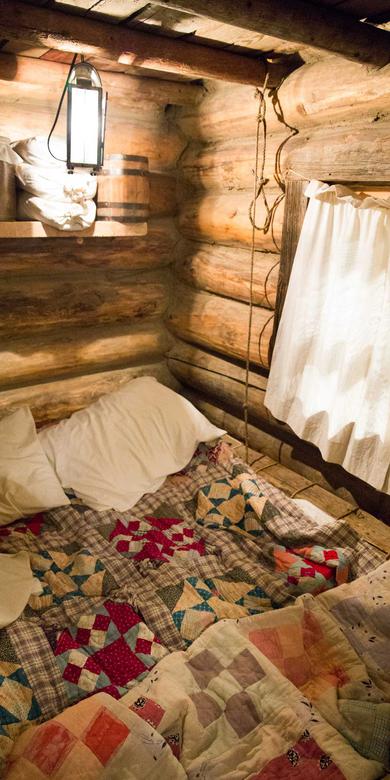
Routes through California, 1846–1848
The sailing ship Brooklyn left New York Harbor in February 1846, bound for California under the leadership of Samuel Brannan. The Brooklyn carried 239 Latter-day Saints and supplies for anticipated Mormon settlements in the West.
That summer, the United States declared war on Mexico in hopes of adding California to its territory. About 500 men and several women and children volunteered to march from Iowa to the Pacific Ocean in what became known as the Mormon Battalion. Their service helped provide funds that enabled many of their fellow Saints to gather to Zion.
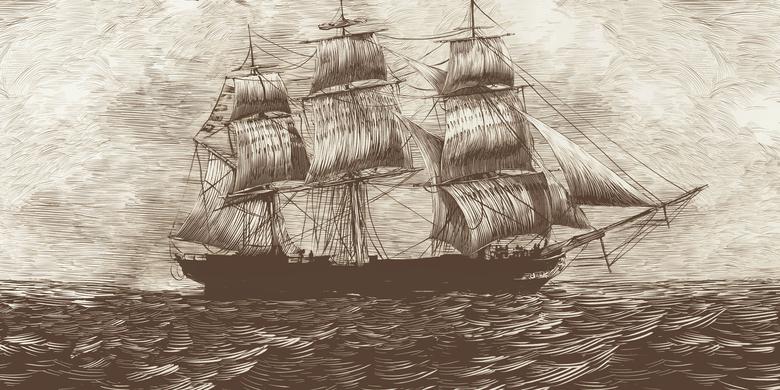
“On Saturday, before taking up the line of march, President Young [and others] . . . gave us their last charge and blessing, with a firm promise that on condition of faithfulness on our part, our lives should be spared and our expedition result in great good.”
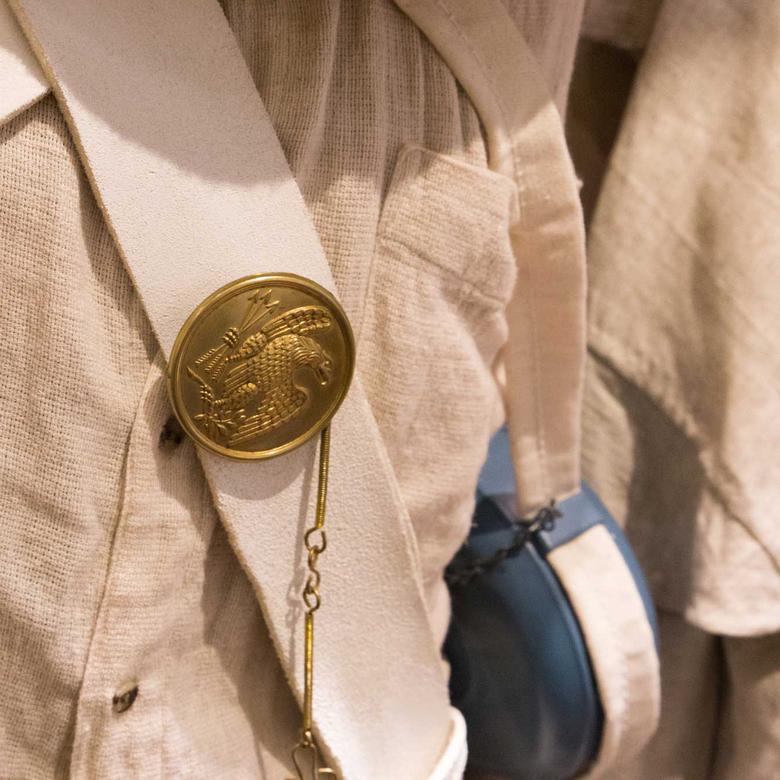
Latter-day Saint volunteers in the Mormon Battalion sent their army pay back to Winter Quarters to help their families. Besides the money they were paid, soldiers gained experience on the march to California that helped them lead others across the continent to the Rocky Mountains.
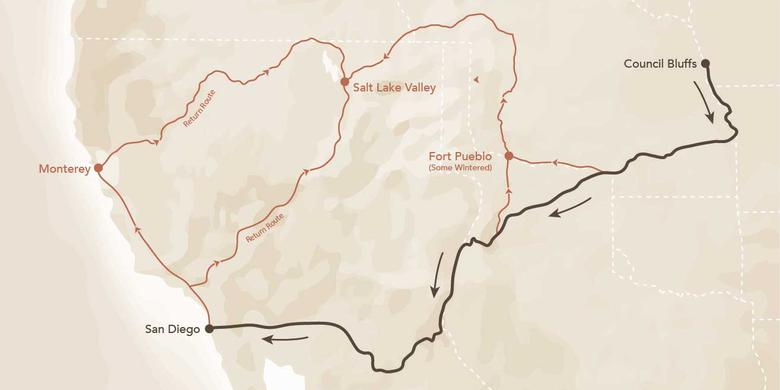
The bulk of the battalion soldiers mustered out at Fort Moore in Los Angeles, California, in July 1847. To reach Utah, some took a southern route across Death Valley; others went north to Sutter’s Fort and followed the California Trail eastward.

Route to the Great Salt Lake, 1847
In January 1847, Brigham Young received a revelation now included as section 136 in the Doctrine and Covenants. Besides practical advice about organizing wagon companies for traveling, the Lord also urged His Apostles to rely on Him along their way. Strengthened by this revelation, Brigham Young’s vanguard company set out in April and arrived at the Great Salt Lake Valley in July. This company of 143 men, 3 women, and 2 children kept careful records that benefited all who followed.
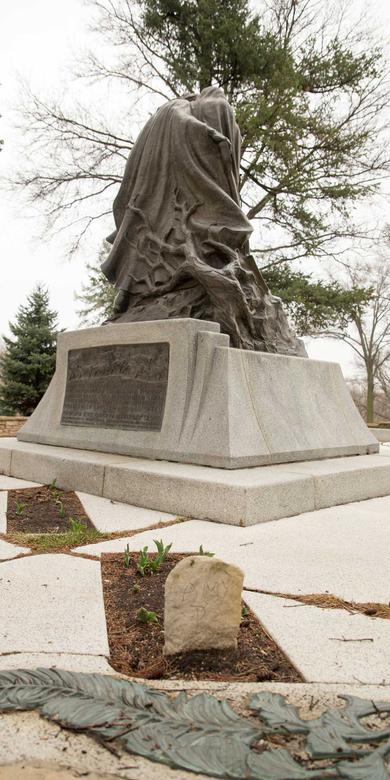
“If thou art sorrowful, call on the Lord thy God with supplication, that your souls may be joyful.”
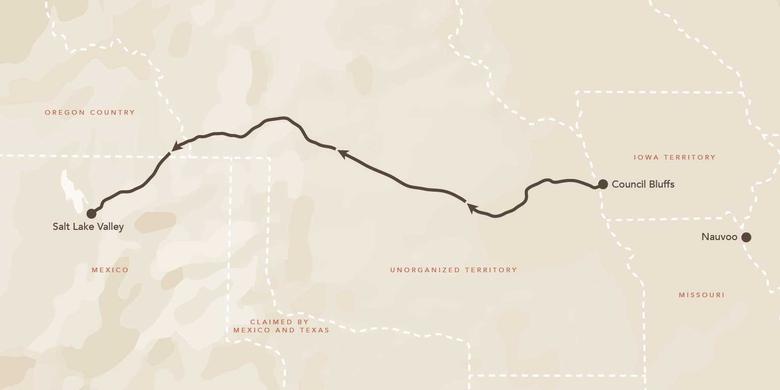
After just two weeks in the Salt Lake Valley, Brigham Young and other members of the Quorum of the Twelve returned to the camps along the Missouri River to prepare their families for the journey west. As they traveled east, they passed westbound wagons that had left Winter Quarters in June. About 2,100 pioneers in 13 wagon companies journeyed to the Salt Lake Valley in 1847. Most arrived in September or early October.
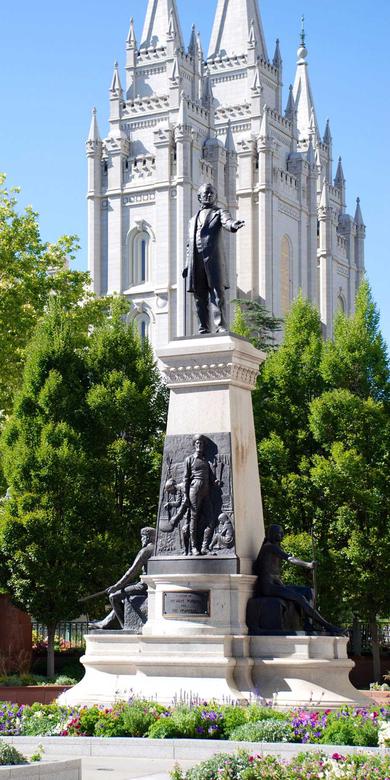
The Trail in the 1850s
Beginning in 1840, Latter-day Saint agents at Liverpool, England, chartered boats for large companies of emigrating Saints. In 1852, agents in Copenhagen, Denmark, began making similar arrangements for Danish and other Scandinavian converts—later joined by German, Swiss, Italian, and French converts. Beginning in 1852, many European Saints emigrated using contributions to the Perpetual Emigrating Fund—a revolving loan system that subsidized travel costs. As a result of improved organization and funding, the 1850s included the busiest years for the Mormon Trail.
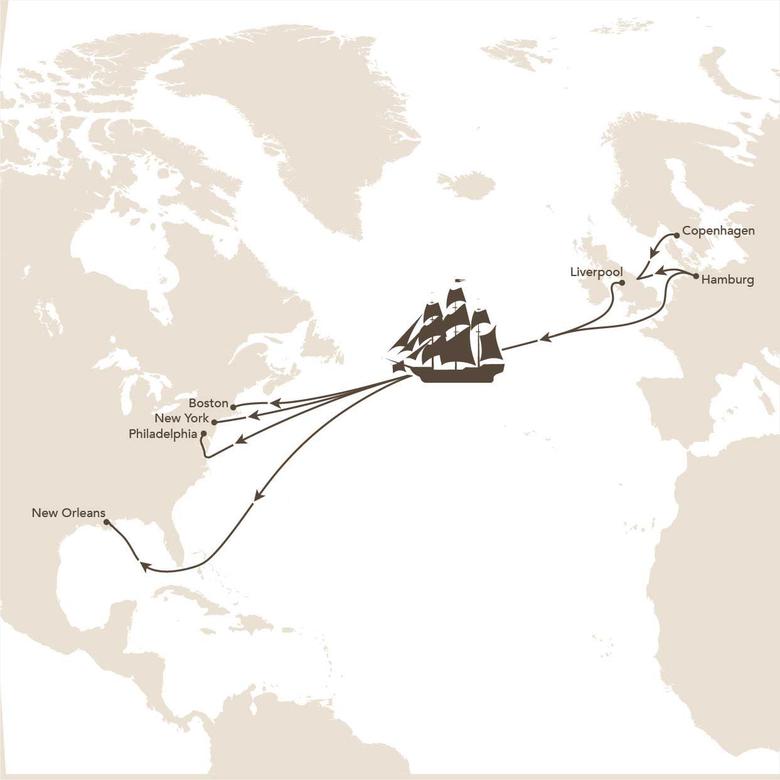
Handcart companies provided determined Saints with an alternative, economical way to reach Zion. Out of about 70,000 Mormon pioneers who traveled before 1869, only about 3,000 used handcarts. Yet their dramatic stories of faith and perseverance have become emblematic of the pioneer spirit.
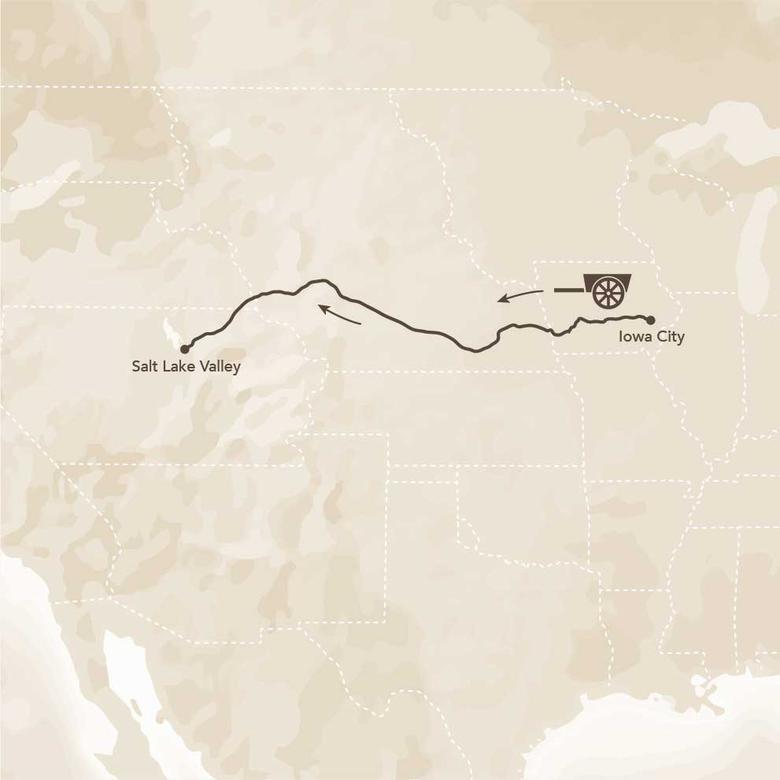
From Wagon Roads to Railroads
After 1860, Church-sponsored down-and-back wagon trains replaced handcarts as an inexpensive way for impoverished Saints to reach Zion. Most pioneers during the 1860s came to Zion in companies using this economical method of gathering until the Transcontinental Railroad arrived in Utah in 1869. After that, the combined steam power of ocean liners and rail locomotives made it possible for European Saints to travel from their homelands to the Rocky Mountains in just over three weeks and for a fraction of the cost.
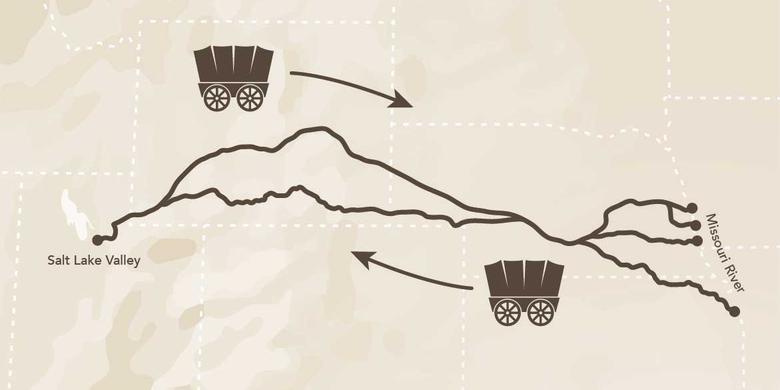
The Pacific islands, Australia, and New Zealand were the homelands of hundreds of Saints by 1890. Like the approximately 55,000 British and 25,000 Scandinavian converts, many Pacific Saints traveled by sail, trail, and rail across ocean, mountain, and desert to reach Zion.

“The days of pioneering in the Church are still with us; they did not end with covered wagons and handcarts. . . . [The pioneers] marked the path and led the way. Ours is the obligation to enlarge and broaden and strengthen that path until it encompasses the whole earth.”
Explore Further
Gospel topics.
Museum Treasures series
Mormon Handcart Historic Sites
Revelations in Context
Revelations in Context series
Chad M. Orton “ ‘This Shall Be Our Covenant’: D&C 136 ,” Revelations in Context series, Feb. 25, 2015, history.lds.org
“Pioneer Trek,” Church History Topics
“Pioneer Trek”
Pioneer Trek
Between 1847, when Latter-day Saint pioneers first entered the Salt Lake Valley, and 1868, when the transcontinental railroad neared completion, between 60,000 and 70,000 Latter-day Saints migrated from the United States, Canada, and Europe across the North American Great Plains to Utah and the surrounding regions. 1 Most immigrants journeyed in wagon trains or handcart companies along a network of trails that generally took months to cross. The records of those who made this trek describe their diverse experiences, which included episodes of disease, danger, bravery, and miracles, but mostly stretches of uneventful travel and inspiring scenes of outdoor beauty.
A pioneer company winding down Echo Canyon in the 1860s.
A revelation given to Brigham Young in 1847 likened this journey to the Biblical exodus: “I am he who led the children of Israel out of the land of Egypt,” the Lord said, “and my arm is stretched out in the last days to save my people Israel.” 2 He commanded the Saints to organize into companies and provide for each other, especially the poor, widowed, and orphaned. Answering this call to help all the Saints reach Zion and leave no one behind, Brigham Young and other Church leaders employed multiple methods. Between 1847 and 1861, most migrants made the overland journey in wagons, with a few going by handcart, typically outfitting their companies near the present-day border of Nebraska and Iowa. 3 In 1849 Brigham Young established the Perpetual Emigrating Fund Company to provide financial assistance to Saints who could not afford the journey. After they settled, they were expected to repay the company so others could receive similar help. 4 Between 1861 and the completion of the transcontinental railroad in 1869, a “down-and-back” system allowed migrants and missionaries to haul supplies in wagons back and forth along the trail in both directions, which considerably reduced outfitting costs. 5
For most Latter-day Saint migrants, the roughly 1,000-mile (1,600-kilometer) overland journey capped a much longer passage. Thousands of European Saints crossed the Atlantic by ship, most often from Liverpool to New Orleans, then boated up the Mississippi and Missouri Rivers to the main overland departure site in the greater Winter Quarters and Kanesville area. Some ships, like the Brooklyn in 1846, sailed around the horn of South America and up the Pacific Ocean to California. 6 Some traveled other routes to the Salt Lake Valley from California, southeastern Texas, and western Missouri.
The first overland company, called by Brigham Young the “pioneer company” (later the “vanguard company”), left Winter Quarters in April 1847 following the Oregon Trail, a route first blazed by other frontier travelers. Between Iowa and western Wyoming, the Oregon Trail, the Mormon Trail (as the Saints’ route to Utah came to be known), and later the California Trail all followed essentially the same route. For the last leg of the Latter-day Saint pioneers’ journey, the Mormon Trail diverged and headed southwest from Fort Bridger (in present-day Wyoming) toward Salt Lake City. More than half a million migrants, including the majority of gathering Saints, used this trail system from 1843 until 1868, when the Union Pacific Railroad began to connect most of the Oregon Trail’s outposts. 7
Published trail guides, featuring maps and references to landscape features, directed pioneer companies along these trails. Most companies encountered other groups along the trail and frequently traveled on the opposite side of rivers from other groups to avoid competing for water, campsites, and forage. Travelers ranged widely to make sure they had food for their livestock and often scouted for shortcuts, creating more of a broad corridor than a narrow trail line. Recognizing they were traversing American Indian homelands, the Saints took precautions against encounters but quickly learned that Indian groups typically helped rather than threatened their travels. While Indians in some instances captured horses and burned prairie grass to divert bison away from Latter-day Saint hunters, they were often hospitable and sometimes offered to push handcarts or help the migrants ford rivers. 8
A typical day in a wagon company was full of activity. “I never saw so busy a time as in traveling with the camp—there was hardly ever a minute to spare,” Oliver Huntington recorded in his journal. 9 The routine consisted of members of the company rising for prayer and breakfast, then collecting livestock animals from their evening foraging, yoking the animals to wagons, and driving wagons further down trail, a distance averaging 15 to 20 miles (24 to 32 kilometers) in fair weather. Men and boys rotated moving a herd of livestock behind the wagon train and keeping watch over grazing. Upon settling down for the evening, the company unyoked cattle and gathered fuel for cooking. 10 Travelers enjoyed reading, playing music, dancing, and gathering for meetings. They seldom rested long, usually only for inclement weather, to partake of the sacrament, or on the Sabbath.
Entering the Salt Lake Valley was a memorable experience for those who made the arduous journey. “I never shall forget the last day we traveled, and arrived in the Valley,” wrote Ann Agatha Walker Pratt. “Oh! how my heart swelled within me, I could have laughed and cried, such a comingling of emotions I cannot describe.” 11 As settlements in the valley became more established, most new arrivals received temporary accommodation from Saints already living there until they could find their own new home in Zion. 12
Related Topics: Emigration , Salt Lake Valley , Handcart Companies

- History for Kids
The Mormon Trail: A Photographic Exhibit
June 3, 2016
Curated in 1997 by Linda Thatcher
During the 1800s more than 500,000 emigrants crossed the Western plains hoping to find a new and better life for a variety of reasons. One of the largest groups to move west was the Mormons. From 1847 to 1868, 70,000 Mormon pioneers made the trek on foot, in wagon trains, or handcart companies to “Zion” (Salt Lake Valley) hoping to find a home where they could practice their religious beliefs without persecution. Those traveling to “Zion” came from a variety of backgrounds starting with the Saints that had been driven out of Nauvoo, to church members converted to Mormonism in England, Wales and Denmark.
In 1997 Utah and The Church of Jesus Christ of Latter-day Saints celebrated the Sesquentennial of the Mormon migration to honor the thousands of pioneers who made the trek to Utah. This photo exhibit was produced for the Sesquicentennial for schools and other interested groups to exhibit. The exhibit is presented here for those interested in the Mormon Trail to view.
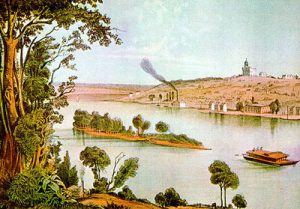
Nauvoo, Illinois. Color print by A. Henry Lewis.
By 1845 the Mormon population in and around Nauvoo, had grown to more than 11,000, making it one of the largest cities in Illinois. In September 1845 more than 200 Mormon homes and farm buildings were burned in an attempt to force the Mormons to leave the area. A move to the Far West had been discussed by LDS Church leaders as early as 1842, with Oregon, California, and Texas considered as potential destinations. In 1844 Joseph Smith obtained John C. Fremont’s map and report, which described the Great Salt Lake and its surrounding fertile valleys. Subsequently, the Rocky Mountains and the Great Basin became the prime candidates for settlement.
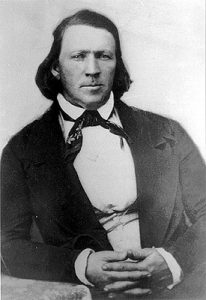
Brigham Young as he looked in about 1850
Under the leadership of Brigham Young the Mormons left Nauvoo earlier than planned because of the revocation of their city charter, growing rumors of U.S. government intervention, and fears that federal troops would march on the city. They left Nauvoo on February 4, 1846.
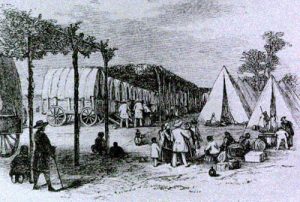
A Mormon camp in Iowa along the route to Winter Quarters after expulsion from Nauvoo in 1846.
After crossing the Mississippi River, the Mormons followed primitive territorial roads and Indian trails across Iowa. Their early departure exposed the pioneers to the worst winter elements. Heavy rains turned the rolling plains of southern Iowa into axle-deep mud. Furthermore, few pioneers carried adequate provisions for the trip. The weather, general unpreparedness, and lack of experience in moving such a large group of people, all contributed to the difficulties they endured. The Mormon migration came to be known for its preparedness, orderliness, discipline, safety, and effective organization, but that was later. The diaries written in those cold wagons during February and March yield a picture of confusion, disorder, and severe hardship. On March 27, 1846, Brigham Young issued instructions to organize the group into companies of 100s, 50s, and 10s.
A scene along the Mormon trail
The historic Mormon Trail developed in two stages: (1) from Sugar Creek across Iowa to Council Bluffs in the winter and spring of 1846, and (2) from Winter Quarters near Council Bluffs to the Rocky Mountains in the summer of 1847.
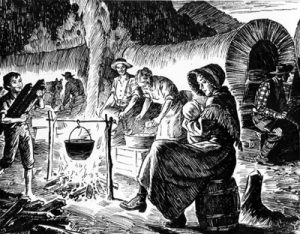
Camp at the end of the day
Brigham Young continued to exert his authority over the pioneers. On April 18, 1846, he laid out the daily routine of the camp: At five o’clock in the morning the bugle is to be sounded as a signal for every man to arise and attend prayers before he leaves his wagon. Then the people will engage in cooking, eating, feeding teams, etc., until seven o’clock, at which time the train is to move at the sound of the bugle. Each teamster is to keep beside his team with loaded gun in hand or within easy reach, while the extra men, observing the same rule regarding their weapons, are to walk by the side of the particular wagons to which they belong; and no man may leave his post without the permission of his officers. In case of an attack or any hostile demonstration by Indians, the wagons will travel in double file—the order of encampment to be in a circle. At half past eight each evening the bugles are to be sounded again, upon which signal all will hold prayers in their wagons, and be retired to rest by nine o’clock. Other rules included a noon rest for the animals. (The travelers were to have their dinner precooked to avoid the necessity of cooking at noon.) At night the wagons were drawn into a circle, and the animals grazed inside it where possible. When stock had to be staked out at night for feed, extra guards were posted.
All persons were to start together and keep together. A guard at the rear saw that nothing was left behind. Of course, even with strict discipline the realization of this ideal fell short at times.
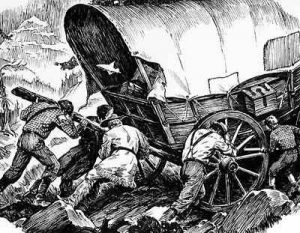
The trail over a steep mountain
Notwithstanding the better organization, it would be difficult to exaggerate the hardships of those first weeks on the trail. Sunrise temperatures were almost invariably below freezing until after April 15, 1846. Daytime temperatures rose enough to thaw the ground, and the heavily laden wagons became half-sunk in quagmires. Snowstorms continued through March. Rainstorms, sometimes lasting for days, pelted the wagon-dwellers much of April and May. Near Richardson’s Point, Iowa there was “one mud hole, six miles long.” Hosea Stout wrote on April 29, 1846, “This was an uncommonly wet rainy, muddy, miry disagreeable day. Very wet night last night the ground flooded in water[.]”
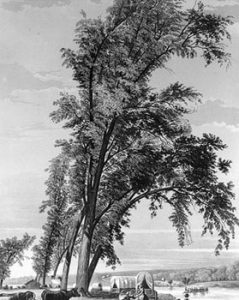
Crossing at Council Bluffs on the overland trail to the Far West. Frederick J. Piercy sketch
During the first stage of their journey in early June 1846 the camp moved on toward Council Bluffs, some 90 miles to the west, leaving behind enough people to improve and maintain Mount Pisgah for the benefit of future Saints going west. On June 13, the camp reached the Council Bluffs area at the Missouri River, and the first portion of the march was nearly over. In the Council Bluffs area the Mormons were not yet in the wilderness. In southern Iowa and eastern Nebraska between 1846 and 1853 the Mormons built at least fifty-five temporary and widely separated communities, farmed as much as 15,000 acres of land, and established three ferries. These numerous communities were established primarily to accommodate the thousands of Mormon emigrants, while they were waiting to cross either the Missouri River, or resting and preparing financially and physically to continue westward to Utah.
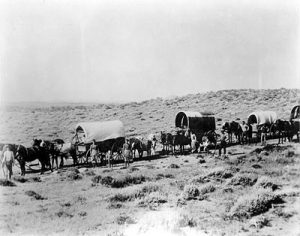
Covered wagon train scene in 1882
In early April 1847 the Mormon pioneers began the second stage of their trek west. Wagons began to trickle out of Winter Quarters in small groups. Near North Platte, Nebraska craftsmen devised a “roadometer” at the suggestion of William Clayton. Where it was first used is now known as the Odometer Start. Previously Clayton had kept track of distance by tying a red cloth to a wheel and counting the revolutions.
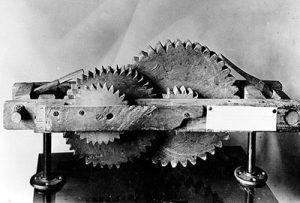
The roadometer was used by pioneers to measure the distance across the plains.
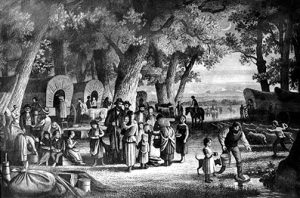
Camp along the trail
Life was hard on the trail. Women regularly began the trail day by getting up an hour or half an hour before the men to stoke the fire, heat the kettles of water to begin breakfast, milk the cow, etc. Cooking in the open was a new experience for most women. Two forked sticks were driven into the ground, a pole laid across, and the kettle swung upon it. Pots were continually falling into the fire, and families soon became accustomed to ashen crust on their food. After breakfast the women washed the tinware, stowed away the cooking equipment and food, and packed up while the men readied the wagons. After several hours on the road there was a brief stop at noon. Then the women brought out lunch usually prepared the night before. By evening everyone was ready to camp, where the work continued. The fire had to be kindled and water brought to camp. Men chopped wood, and children collected sagebrush, cottonwood twigs, or buffalo chips for the fire. Typical meals consisted of bacon, beans, cheese, boiled and mashed potatoes, dried fruit, homemade bread, biscuits, puddings. Some women even prepared preserves and jellies from wild berries and fruit gathered along the way. In the evening beds had to be made up, wagons cleaned out, and clothes mended or washed. Men fed and watered the livestock, mended harnesses, or repaired wagons in the evening; the work never ended for everyone on the trail.

Approaching Chimney Rock along the North Platte River in Nebraska. William Henry Jackson, 1929
One of the great landmarks on the emigrant trail was Chimney Rock in Nebraska, so named because its slender pillar rising above the bluffs resembled a giant chimney. The rock was shown on all early maps, and the Mormon pioneers were anxious to see it, both because of it fame and because it would give them a chance to check the accuracy of their maps. On May 22, 1847, Porter Rockwell rode into camp with some exciting news. He said he climbed atop a high bluff a mile distant and had seen Chimney Rock. But the emigrants did not reach the rock until May 26—where Orson Pratt estimated the height of the shaft at 260 feet.
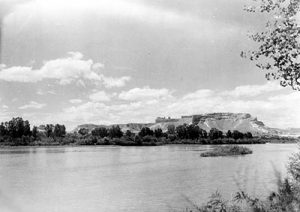
Scott’s Bluff from across the North Platte River
The trail across the Great Plains traversed hundreds of miles along the north side of the Platte and North Platte rivers. At Fort Laramie the Mormons crossed to the south side of the river, where they joined the Oregon Trail.
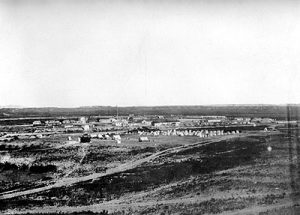
Fort Laramie, Wyoming, William Henry Jackson photograph
At Fort Laramie members of the Pioneer Company were halfway to their destination. From this point on, it was decided, they would follow the Oregon Trail. Terrain dictated the decision for the most part. They rented a flatboat for $15.00 and began ferrying their wagons across the river. They stayed at Fort Laramie for three days and obtained supplies at high prices—cotton and calico were a $1.00 per yard, flour was 254 a pound, a cow cost $15-$20 and a horse about $40. On June 4 started up the Oregon Trail, heading west and northwest, gaining in elevation over roads sometimes quite hilly. Making about 13 miles a day, their journey brought them on June 12 to where the Oregon Trail crossed the North Platte, 124 miles from Fort Laramie. Here (at present Casper) the Mormons remained six days, hunting and fishing and building rafts to ferry wagons. On the June 19 the pioneers’ company left the North Platte and rolled southwestward toward the Sweetwater River.
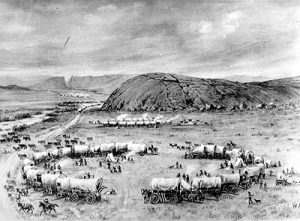
Independence Rock on the Mormon Trail by William Henry Jackson
On June 23 they reached Independence Rock, one of the most famous landmarks on the entire Mormon Trail. William Clayton wrote in his journal: “We can see a hugh pile of rocks to the southwest a few miles. We have supposed this to be the rock of Independent.” It is an oval-shaped outcrop of granite 1,900 feet long, 700 wide, and about 130 wide. Of the various stories regarding its name, the favorite is that some early trappers once celebrated the Fourth of July there. Mormons climbed it, danced on it, and painted and carved their names on it. The trail passed between the rock and the Sweetwater River in Wyoming.
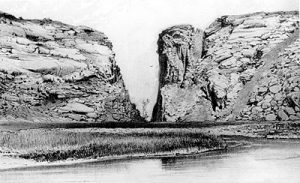
Devil’s Gate, Sweet Water River, Rocky Mountains, 1869. Charles R. Savage, photographer
A few miles farther and the pioneers reached Devil’s Gate, another Oregon Trail landmark. The gate was a chasm 330 feet deep with the Sweetwater River running between the cliffs for about 200 yards. The pioneers camped a short distance beyond Devil’s Gate and many of them walked back to get a better view. Thomas Bullock called it “a romantic spot.”
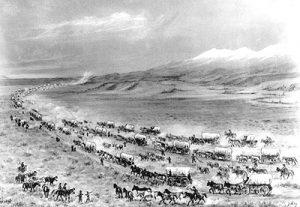
South Pass, Wyoming, by William Henry Jackson
On June 26 the pioneers marched into the 25-mile-wide plain that is South Pass (which made the wagon trek west possible) near the Continental Divide-where waters west of the summit flow into the Pacific Ocean. The ascent on the broad plain is so gradual that many of the travelers crossed the Continental Divide without being aware of it since the Pass is 7,700 feet high, the pioneers sometimes enjoyed a snowball fight. On June 28 the company met Jim Bridger, on his way to Fort Laramie, who spent the night with them. Bridger gave a long account of the country around the Great Salt Lake. Bridger felt that one disadvantage to settling in the region was the cold nights. William Clayton reported: “He thinks Utah Lake is the best country in the vicinity of Salt Lake and the country is still better the farther south we go until reaching the desert about 200 miles south of Utah Lake.”
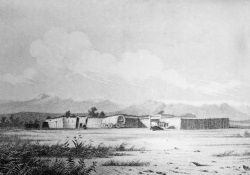
Fort Bridger, Wyoming, by William Henry Jackson
On July 7 the pioneers made it their goal to reach Fort Bridger-not because the trading post was important to them but because it marked the beginning of the last leg of their long trek. The structure was built in 1842 by Jim Bridger and opened as a trading post the next year by Bridger and his partner, Louis Vasquez. It was the second permanent settlement in Wyoming. The fort did business in the fur trade with trappers, mountain men, and Indians. As emigrants moved along the Oregon Trail, the post acquired many new customers. Having reached Fort Bridger the Mormon pioneers decided to “stay a day here and set some tires,” as well as rest their animals and do some shopping. Prices at Fort Bridger were higher than they had found at other trading places along the trail. Shirts cost $6.00, pants $6.00, and dressed animal skins $3.00 each.
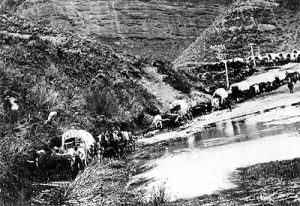
Emigrant train in Echo Canyon on the way to Salt Lake City in 1867. The poles were used by the Transcontinental Telegraph, completed in the fall of 1861
On July 16 the pioneers reached “a narrow revine” Echo Canyon and attempts to travel along the bottom proved to be a struggle. Occasionally teams had to be doubled to get over obstacles. The company penetrated farther into the canyon. As they did, “the mountains seem to increase in height and come so near together as too barely leave room for a crooked road,” according to William Clayton. The wagons exited Echo Canyon and moved to near what is now Henefer. Ahead lay 36 miles of rugged mountains that taxed the strength of the pioneers and their teams.
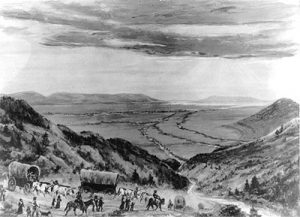
Painting by William Henry Jackson depicting the pioneers first view of the Salt Lake Valley in 1847
Orson Pratt’s advance guard was some distance in front of the main body, trying to improve the trail. Pratt and Erastus Snow were the first to enter the Salt Lake Valley on July 21, 1847, and a larger group followed on July 22, 1847. Thomas Bullock caught his first full view of the valley on July 22 and shouted “hurra, hurra, hurra, there’s my home at last.”
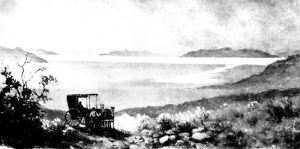
Hafen Brigham Young’s First View of the Valley. Artist John Hafen’s painting of the Mormon pioneers first view of the Salt Lake Valley
Brigham Young had fallen sick with “mountain fever” and was bringing up the rear with eight wagons. He was among the last to enter the valley, but his arrival July 24 made it official. Traveling six miles through Emigration Canyon “we came in full view of the great valley or basin,” according to Wilford Woodruff. “A land of promise, held in reserve by the hand of God for a resting place of the saints,” he thought, and declared this moment “an important day in the history of my life and the history of the church.” Young, still feeling weak, “expressed his full satisfaction in the appearance of the valley as a resting place for the saints and said he was amply repaid for the journey,” Woodruff later wrote. Nothing was mentioned in Woodruff’s journal at the time about Brigham’s having said, “This is the place.” Thirty-three years later, in recalling the 1847 event, Woodruff said that Young, looking over the expanse below, saw the future glory of the valley and said: “It is enough. This is the right place, drive on.”

View of Salt Lake City in 1853, sketched by Frederick J. Piercy. This is one of the earliest views of Salt Lake City
At once the settlers began building their new empire. They diverted water from City Creek, planted crops, planned and laid out their city, and built homes. Brigham Young immediately set aside several acres for the Mormon Temple. Many early visitors were impressed with the layout of the city and commented on its clean, neat appearance. By 1850 there were 11,380 people living in Utah, and one visitor described Salt Lake in 1850 as “a large garden laid out in regular squares.” Mark Twain noted the clean streams that trickled through town. Mormons continued to arrive during the remaining weeks of summer and fall, and approximately 1,650 people spent that first winter in the valley. After organizing the settlement, Brigham Young and many members of the pioneer party made the return trip to Winter Quarters to be with their families and to help organize the next spring’s migration to the valley.

Journey to Zion: Voices from the Mormon Trail
Carol cornwall madsen.
750 pages, Hardcover
First published January 1, 1997
About the author

Ratings & Reviews
What do you think? Rate this book Write a Review
Friends & Following
Community reviews.

Join the discussion
Can't find what you're looking for.

Mormon Pioneer Children – As They Journeyed to Zion
by Keith L. Brown | Jan 7, 2015 | Historical Stories | 0 comments
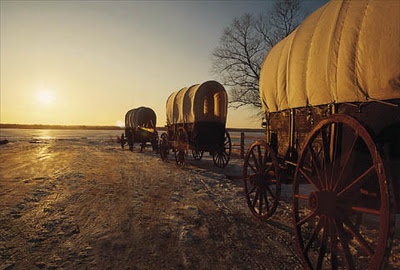
The trail which the early Mormon pioneers forged through sweat, tears, and oftentimes at the cost of life itself, was an arduous one at best for both adults and children. In spite of all their hardships, they never lost faith, but with every footstep remained stalwart as they trekked to the land that would become known to them as Zion.
Sadly, many of the children would lose their parents to death along the trail. However, even in their final moments, their parents’ hopes and prayers were that their progeny would reach Zion and have a better life for themselves and all future generations. In such times, these children were robbed of the innocence of their youth as they were forced to mature and take on adult responsibilities at an early age. Nevertheless, they were determined to fulfill their parents’ desires, and continued the journey, albeit with heavy hearts. Along the way, many of the children would have stories of their own to tell about their experiences.
Mormon Children on the Pioneer Trail
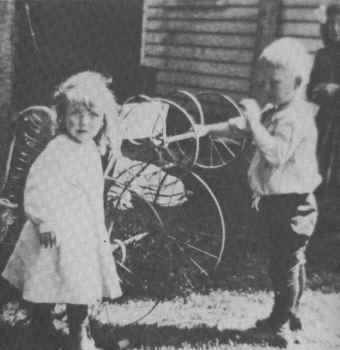
Albert recorded the following in his journal :
We crossed the Missouri on a large flatboat. Two wagons went on each trip, with three men to the oar and one at the rear to steer. They would land down the river about one mile from the starting point, then pull the boat back with oxen.
When the entire party, which consisted of 60 wagons, had gathered on the other side of the river, they were divided into groups of ten with a captain appointed as leader of each group. Children comprised at least half of the company. The older children usually walked beside the wagons, with some being given the responsibility to herd the sheep. The younger children also walked during part of the day, but were allowed to ride in the wagons as they grew weary.
According to the article by Fay McCracken titled “ Children Pioneers ” in the July 1995 issue of the Friend magazine:
The group followed the Mormon Trail, which had been cleared in 1847 as a route for the migration of Church members to the Salt Lake Valley. It followed the north side of the Platte River to the fork of the North Platte and South Platte, then ran along the North Platte to Fort Laramie, where the pioneers crossed the river and followed the Oregon Trail to Fort Bridger. From there they traveled down Weber Canyon and Emigration Canyon into the Salt Lake Valley. The entire trip was about 1100 miles.
The company that Albert and his family traveled with was the fourteenth to leave for the west that spring, and the trail which the pioneers traversed was well marked and well-traveled. As the pioneers continued their trek westward, one of the first challenges that they faced was disease such as cholera which affected adults and children alike. Two members of the company succumbed to the disease at the first camp on the Platte River, and by the time they reached Loup Fork, a total of twelve would die from the dreaded disease.
With the large number of buffalo that were sited on the trail, buffalo meat soon became a staple, and oftentimes members of the company would leave messages on buffalo skulls for those yet to come.
Contrary to many wise tales, although Indian tribes were encountered along the way, they never presented much of a problem to the Mormon pioneers. In fact, they would often visit the camps and were given gifts such as beads and fishhooks. Because of the hospitality that was shown to them, the Indians did not attack the wagon trains.
Remembering the Sabbath Day
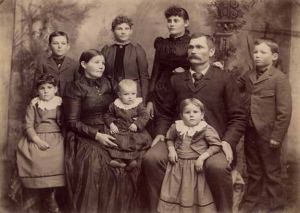
Although the rigors of the journey were long and hard, the Mormon pioneers always remembered to take time to observe the Sabbath. The rest from the arduous journey was welcomed by everyone, especially the children as they attended Sunday school with their friends, sang songs, listened to stories, visited with the other children, and explored the nearby countryside.
They the Builders of the Nation
The company reached their halfway point, Fort Laramie by midsummer, and on the first of October, they entered the Salt Lake Valley – their new home – Zion.
Mormon Pioneer Children Became Leaders in Utah
Usually when a person thinks about Mormon pioneers, they are more familiar with the stories of the adults that made the trek to the west. However, a majority of the western pioneers were actually young children like Albert Dickson who eventually moved to Morgan County where he became the first Bishop of the Richville Ward, and served for 37 years. As these pioneer children grew older, they became the builders and leaders of thriving communities. They literally became the builders of a great nation which was forged out of barren and hostile lands. Their skills and leadership abilities were partially developed during their trek to Zion.
Facebook • Twitter • Linkedin • Google • Instagram •
Submit a Comment Cancel reply
Your email address will not be published. Required fields are marked *
Save my name, email, and website in this browser for the next time I comment.
- Book of Mormon
- Book of Mormon Translations
- Current Church Leader Bios
- Early History
- European Saints
- General Conference
- Historical Landmarks
- Historical Stories
- Inspiring Stories from Latter-day Saints
- Interesting Church Members
- Joseph and Emma Smith Descendants
- Joseph Smith
- Joseph Smith's Family
- LDS Views on War
- Modern History
- Mormon Beliefs
- Mormon Historical Sites
- Mormon Missionary
- Mormon Temples
- Mormon Women Leaders
- Past Leader Bios
- Uncategorized
- Voice of Christ
- Who's Who in Mormon History
Free Scriptures
The Mormon Church distributes free copies of the King James Version of the Bible and the Book of Mormon . For your free copy of the Bible, go to Free Holy Bible and for a free Book of Mormon, go to Free Book of Mormon
Joseph Smith's First Vision

Pin It on Pinterest
Share this post with your friends!
We will keep fighting for all libraries - stand with us!
Internet Archive Audio

- This Just In
- Grateful Dead
- Old Time Radio
- 78 RPMs and Cylinder Recordings
- Audio Books & Poetry
- Computers, Technology and Science
- Music, Arts & Culture
- News & Public Affairs
- Spirituality & Religion
- Radio News Archive

- Flickr Commons
- Occupy Wall Street Flickr
- NASA Images
- Solar System Collection
- Ames Research Center

- All Software
- Old School Emulation
- MS-DOS Games
- Historical Software
- Classic PC Games
- Software Library
- Kodi Archive and Support File
- Vintage Software
- CD-ROM Software
- CD-ROM Software Library
- Software Sites
- Tucows Software Library
- Shareware CD-ROMs
- Software Capsules Compilation
- CD-ROM Images
- ZX Spectrum
- DOOM Level CD

- Smithsonian Libraries
- FEDLINK (US)
- Lincoln Collection
- American Libraries
- Canadian Libraries
- Universal Library
- Project Gutenberg
- Children's Library
- Biodiversity Heritage Library
- Books by Language
- Additional Collections

- Prelinger Archives
- Democracy Now!
- Occupy Wall Street
- TV NSA Clip Library
- Animation & Cartoons
- Arts & Music
- Computers & Technology
- Cultural & Academic Films
- Ephemeral Films
- Sports Videos
- Videogame Videos
- Youth Media
Search the history of over 866 billion web pages on the Internet.
Mobile Apps
- Wayback Machine (iOS)
- Wayback Machine (Android)
Browser Extensions
Archive-it subscription.
- Explore the Collections
- Build Collections
Save Page Now
Capture a web page as it appears now for use as a trusted citation in the future.
Please enter a valid web address
- Donate Donate icon An illustration of a heart shape
Journey to Zion : voices from the Mormon Trail
Bookreader item preview, share or embed this item, flag this item for.
- Graphic Violence
- Explicit Sexual Content
- Hate Speech
- Misinformation/Disinformation
- Marketing/Phishing/Advertising
- Misleading/Inaccurate/Missing Metadata
![[WorldCat (this item)] [WorldCat (this item)]](https://archive.org/images/worldcat-small.png)
plus-circle Add Review comment Reviews
24 Previews
3 Favorites
Better World Books
DOWNLOAD OPTIONS
No suitable files to display here.
PDF access not available for this item.
IN COLLECTIONS
Uploaded by station19.cebu on May 19, 2021
SIMILAR ITEMS (based on metadata)
BYU Harold B. Lee Library
Trails of hope: overland diaries and letters, 1846–1869.
- Collections
- Overland Trails
Suggested Readings
Melvin l. bashore, susan l. fales, fred r. gowans, and michael n. landon.
“Trails of Hope” readers will hopefully want to capture the depth and breadth of the trails experience beyond what is possible in any one publication. If you are a reader new to the trail, this “Suggested Readings” can begin a rich discovery process. Along with the diaries in this collection, the list of readings will provide context for the journeys on the Mormon, California, Oregon, and Montana trails.
The issues explored by the diarists represented in “Trails of Hope,” and by the authors of these selected readings, are as varied as the writer’s own experiences and interests. Trail enthusiasts can debate endlessly, over campfires and wood stoves, questions regarding: the number of overlanders on the various trails; disease, sickness and death and which trail or time period revealed more intensity of disease or death; Native American interactions and which Indian tribes presented the most difficulties for the overlanders and which trail disrupted the Native American existence the most. These same trail enthusiasts may also be interested in an examination of changes in the trail experience over time, the physical trail and its demands on the traveler, and social role changes, especially among women and children.
For those readers who are looking for additional diaries, a review of the “Sources, Bibliographies and Guides” section of this bibliography will lead them to repositories holding original diaries or to printed diaries and journals. Additional diaries and journals may be found by contacting specific libraries or going to the online catalogs of major repositories of these diaries and journals such as Yale University, Princeton University, The Bancroft Library at the University of California-Berkeley, The Huntington Library, the Church Archives of the Church of Jesus Christ of Latter-day Saints, and other libraries with strong western Americana manuscript collections
The Context: The American Westward Movement
Billington, Ray Allen, and Martin Ridge. Westward Expansion, A History of the American Frontier , 5th ed. New York: Macmillan, 1982.
Faragher, John Mack. Women and Men on the Overland Trail . Yale Historical Publications Miscellany, 121. New Haven: Yale University Press, 1979.
Hafen, LeRoy R., W. Eugene Hollon and Carl Coke Rister. Western America, The Exploration, Settlement, and Development of the Region beyond the Mississippi . 3rd ed. Englewood Cliffs, NJ: Prentice-Hall, 1970.
Jackson, W. Turrentine. Wagon Roads West: A Study of Federal Surveys and Construction in the Trans-Mississippi West, 1846-1869 . Lincoln: University of Nebraska Press, 1979.
Jeffrey, Julie Roy. Frontier Women: “Civilizing” the West? 1840-1880 . Rev. ed. New York: Hill and Wang, 1998.
Mattes, Merrill J. The Great Platte River Road: The Covered Wagon Mainline via Fort Kearney to Fort Laramie . Lincoln: University of Nebraska Press, 1969. Reprint, Lincoln: University of Nebraska Press, 1987.
Myers, Sandra L. Westering Women and the Frontier Experience, 1800-1915 . Albuquerque: University of New Mexico Press, 1982.
Reid, John Phillip. Law for the Elephant: Property and Social Behavior on the Overland Trail . San Marino, CA: The Huntington Library, 1980.
. Policing the Elephant: Crime, Punishment, and Social Behavior on the Overland Trail . San Marino, CA: The Huntington Library, 1997.
Rohrbough, Malcolm J. Days of Gold: The California Gold Rush and the American Nation . Berkeley: University of California Press, 1997.
Schlissel, Lillian. Women’s Diaries of the Westward Journey . New York: Schocken Books, 1982. Reprint, New York: Schocken Books, 1992.
Unruh, John D. The Plains Across: The Overland Emigrants and the Trans-Missisippi West, 1840-60 . Urbana: University of Illinois Press, 1979.
West, Elliott. Growing up with the Country: Childhood on the Far Western Frontier . Albuquerque: University of New Mexico Press, 1989.
Sources, Bibliographies, and Guides to Overland Trail Diaries, Reminiscences and Repositories
Andrews, Thomas F. “Ho! For Oregon and California!:” An Annotated Bibliography of Published Advice to the Emigrant, 1841-47.” Princeton University Library Chronicle 33 (Autumn 1971): 41-64.
Bashore, Melvin L., and Linda L. Haslam. The Mormon Pioneer Companies Crossing the Plains (1847-1868) Narratives: Guide to Sources in Utah Libraries and Archives . Rev. ed. Salt Lake City: The Church of Jesus Christ of Latter-day Saints, 1989.
Bitton, Davis. Guide to Mormon Diaries and Autobiographies . Provo, UT: Brigham Young University Press, 1977.
Kimball, Stanley B. “Mormon Emigration Trails.” In Mormon Americana , ed. David W. Whittaker, 406-436. Provo, UT: BYU Studies, Brigham Young University, 1995.
Krol, Helen B. “The Books That Enlightened the Emigrants.” Oregon Historical Quarterly 45 (June 1944): 103-23.
Mattes, Merrill J. Platte River Road Narratives: A Descriptive Bibliography of Travel over the Great Central Overland Route to Oregon, California, Utah, Colorado, Montana, and Other Western States and Territories, 1812-1866 . Urbana: University of Illinois Press, 1988.
Mintz, Lannon W. The Trail: A Bibliography of the Travelers on the Overland Trail to California, Oregon, Salt Lake City, and Montana during the Years 1841-1864 . Albuquerque: University of New Mexico Press, 1987.
“Mormon Trail. “ In Studies in Mormon History, 1830-1997 , James B. Allen, Ronald W. Walker, and David J. Whittaker, 789-791. Urbana: University of Illinois Press, 2000.
Townley, John M. The Trail West: A Bibliography-Index to Western American Trails, 1841-1869. Reno, NV: Jamison Station Press, 1988.
Wagner, Henry R. The Plains and the Rockies: A Bibliography of the Original Narrative of the Travel and Adventure, 1800-1868 . Columbus, OH: Long’s College Book Co., 1953.

Atlases and Maps
Baughman, Robert W. Kansas in Maps . Topeka: Kansas State Historical Society, 1961.
Franzwa, Gregory M. Maps of the California Trail . Tucson, AZ: Patrice Press, 1999.
Franzwa, Gregory M. Maps of the Oregon Trail . Gerald, MO: Patrice Press, 1982.
Wheat, Carl I. Mapping the Transmississippi West, 1540-1862 . 5 vols. San Francisco: Institute of Historical Cartography, 1957-63.
California Trail
Bigler, David L., ed. The Gold Discovery Journal of Azariah Smith . Publications on Mormon Studies, vol. 7. Salt Lake City: University of Utah Press, 1990.
Bruff, Joseph Goldsborough. Gold Rush: The Journals, Drawings, and other Papers of J. Goldsborough Bruff . 2 vols. New York: Columbia University Press, 1944.
Bryant, Edwin. What I Saw In California . New York: D. Appleton and Co., 1848.
Cramer, Howard Ross. The California Trail in Idaho: The Salt Lake Cutoff . Burley, ID: Burley District, U.S. Bureau of Land Management, 1974.
The Emigrant Trails West: A Guide to the California Trail . Reno, NV: Trails West, 2000.
Hafen, LeRoy R., and Ann W. Hafen. The Far West and Rockies: General Analytical Index to the Fifteen Volume Series and Supplement to the Journals of the Forty-Niners, Salt Lake To Los Angeles . The Far West and the Rockies Historical Series, 1820-1875, vol. 16. Glendale, CA: Arthur H. Clark, 1961.
. Journals of the Forty-Niners, Salt Lake to Los Angeles: With Diaries and contemporary Records of Sheldon Young, James S. Brown, Jacob Y. Stover, Charles C. Rich, Addison Pratt, Howard Egan, Henry W. Bigler and Others . The Far West and the Rockies Historical Series, 1820-1875, vol. 2. Glendale, CA: Arthur H. Clark, 1954.
Holliday, J. S., ed. The World Rushed In: The California Gold Rush Experience, An Eyewitness Account of a Nation Heading West . New York: Simon and Schuster, 1981.
Korns, J. Roderic and Dale L. Morgan. West From Fort Bridger: The Pioneering of Immigrant Trails Across Utah, 1846-1850 . rev. Will Bagley and Harold Schindler. Logan: Utah State University Press, 1994.
Landon, Michael N., ed. The Journals of George Q. Cannon, vol. 1: To California in ’49 . Salt Lake City: Deseret Book, 1999.
Lewis, Oscar. Sutter’s Fort: Gateway to the Gold Fields. Englewood Cliffs, NJ: Prentice-Hall, 1966.
Lienhard, Heinrich. From St. Louis to Sutter’s Fort, 1846. Norman: University of Oklahoma Press, 1961.
Lorton, William B. Over the Salt Lake Trail in the Fall of ’49 . Scraps of California, 3. Los Angeles: n.p., 1957.
Lyman, Edward Leo and Larry Lee Reese. The Arduous Road: Salt Lake to Los Angeles, the Most Difficult Wagon Road in American History . Victorville, CA: Lyman Historical Research and Pub. Co., 2001.
McGlashan, Charles F. History of the Donner Party, A Tragedy of the Sierra. San Francisco: A. L. Bancroft, 1880. Reprint, Fresno, CA: California History Books, 1973.
McKinstry, Byron N. The California Gold Rush Overland Diary of Byron N. McKinstry, 1850-1852 . Glendale, CA: Arthur H. Clark, 1975.
Manley, William Lewis. Death Valley in ’49: Important Chapter of California Pioneer History. The Autobiography of a Pioneer, Detailing His Life from a Humble Home in the Green Mountains to the Gold Mines of California; and Particularly Reciting the Sufferings of the Band of Men, Women and Children Who Gave “Death Valley” its Name . San Jose, CA: The Pacific Tree and Vine Co., 1894.
Morgan, Dale L. The Humboldt: Highroad of the West. The Rivers of America Series. New York: Rinehart, 1943. Reprint Lincoln: University of Nebraska Press, 1985.
. The Overland Diary of James A. Pritchard from Kentucky to California in 1849 . Denver: Fred A. Rosenstock Co., 1959.
Newell, Olive. Tail of the Elephant: The Emigrant Experience on the Truckee Route of the California Trail, 1844-1852 . A California Sesquicentennial Publication. Nevada City, CA: Nevada County Historical Society, 1997.
Nunis, Doyce B. Jr., ed. The Bidwell-Bartleson Party: 1841 California Emigrant Adventure: The Documents and Memoirs of the Overland Pioneers . Santa Cruz, CA: Western Tanager Press, 1991.
Owens, Kenneth N. “The Mormon-Carson Emigrant Trail in Western History.” Montana, Magazine of Western History 42 (Winter 1992): 14-27.
Potter, David M, ed. Trail to California: The Overland Journal of Vincent Geiger and Wakeman Bryarly. Yale Historical Publications, Mss and Edited Texts 20. New Haven: Yale University Press, 1945.
Rieck, Richard L. “Geography of the California Trails: Part I.” Overland Journal 11 (Winter 1993): 12-22.
Stewart, George R. The California Trail, An Epic with Many Heroes. New York: McGraw-Hill, 1962. Reprint, Lincoln: University of Nebraska Press, 1983.
. Ordeal By Hunger: The Story of the Donner Party. New York: H. Holt, 1936. Reprint, Lincoln: University of Nebraska Press, 1986.
Topping, Gary. “Overland Emigration, the California Trail, and the Hastings Cutoff.” Utah Historical Quarterly 56 (Spring 1988): 109-27.
Montana Trails
Harstad, Peter T. “The Lander Trail.” Idaho Yesterdays 12 (Fall 1968): 14-28.
Doyle, Susan B. Journey to the Land of Gold: Emigrant Diaries from the Bozeman Trails, 1863-1866. 2 vols. Helena, MT: Montana Historical Society Press, 2000.
Lowe, James A. The Bridger Trail: A Viable Alternative Route to the Gold Fields of Montana Territory in 1864 . American Trail Series, 19. Spokane, WA: Arthur H. Clark, 1999.
Madsen, Betty M., and Brigham D. Madsen. North to Montana: Jehus, Bullwhackers, and Mule Skinners on the Montana Trail . University of Utah Publications in the American West, vol. 13. Salt Lake City: University of Utah Press, 1980.
Mormon Trail
Allen, James B., and John W. Welch, eds. Coming to Zion . Provo: BYU Studies, Brigham Young University, 1997.
Bennett, Richard E. We’ll Find the Place: The Mormon Exodus, 1846-1848 . Salt Lake City: Deseret Book, 1997.
Black, Susan Easton, et. al. “Do We Know How Many Latter-day Saints Died Between 1846 and 1869 in the Migration to the Salt Lake Valley?” Ensign 28 (July 1998): 40-44.
Brown, Randy. “Childs’ Cutoff.” Overland Journal 5 (Spring 1987): 17-22.
Bullock, Thomas L. The Pioneer Camp of the Saints: The 1846 and 1847 Mormon Trail Journals of Thomas Bullock . Edited by Will Bagley. Kingdom in the West, vol. 1. Spokane, WA: Arthur H. Clark Co., 1997.
Carter, Lyndia. “The Mormon Handcart Companies.” Overland Journal 13 (Spring 1995): 2-18.
Creer, Leland H. “Lansford W. Hastings and the Discovery of the Old Mormon Trail,” Western Humanities Review 3 (July 1949): 175-186.
Cross, Mary Bywater. Quilts and Women of the Mormon Migrations . Nashville, TN: Rutledge Hill Press, 1996.
Egan, Howard. Pioneering the West, 1846 to 1878: Major Howard Egan’s Diary. Richmond, UT: Howard R. Egan Estate, 1917. Reprint, n.p., n.p., 1996?
Esplin, Ronald K. “’A Place Prepared:’” Joseph, Brigham and the Quest for Promised Refuge in the West.” Journal of Mormon History 9 (1982): 85-111.
Guenther, Todd. “The Burnt Ranch Saga: A History of the Last Crossing of the Sweetwater.” Overland Journal 17 (Winter 1999-2000): 2-32.
Hafen, LeRoy R., and Ann W. Hafen. Handcarts to Zion: The Story of a Unique Western Migration, 1856-60 . The Far West and the Rockies Historical Series, vol. 14. Glendale, CA: Arthur H. Clark, 1960.
Hartley, William G. “Down-and-Back Wagon Trains: Travelers on the Mormon Trail in 1861.” Overland Journal 11 (Winter 1993): 23-34.
Hill, William E. The Mormon Trail, Yesterday and Today . Logan: Utah State University Press, 1996.
Humlston, John K. “Mormon Immigration in the 1860s: The Story of the Church Trains.” Utah Historical Quarterly 58 (Winter 1990): 32-48.
Jackson, Richard H. “The Mormon Experience: The Plains as Sinai, the Great Salt Lake as the Dead Sea, and the Great Basin as Desert-cum-Promised Land.” Journal of Historical Geography , 18 (January 1992): 41-58.
Kimball, Stanley B. Discovering Mormon Trails: New York to California, 1831-1868 . Salt Lake City: Deseret Book, 1979.
. Historic Resource Study: Mormon Pioneer National Historical Trail . Denver: National Park Service, 1991.
. Historic Sites and Markers along the Mormon and Other Great Western Trails . Urbana: University of Illinois Press, 1988.
. “Mormon Emigration Trails.” In Mormon Americana: A Guide to Sources and Collections in the United States , ed. David J. Whittaker, 406-436. Provo: BYU Studies, 1995.
. “The Mormon Migrations of 1846-68 in Perspective.” Overland Journal 14 (Spring 1996): 15-22.
. “The Overland Journey to Zion.” In The Mormon Role in the Settlement of the West , ed. Richard H. Jackson, 1-27. Charles Redd Monographs in Western History, No. 9. Provo, UT: Brigham Young University Press, 1978.
. “Sail and Rail Pioneers before 1869.” BYU Studies 35 no. 2 (1995): 6-42. Reprinted in Coming to Zion , ed. James B. Allen and John W. Welch, 142-73. Provo, UT: BYU Studies, 1997.
Knight, Hal and Stanley B. Kimball. 111 Days to Zion , 3d ed. Salt Lake City: Big Moon Traders, 1997.
Madsen, Brigham D. Gold Rush Sojourners in Great Salt Lake City: 1849 and 1850 . Salt Lake City: University of Utah Press, 1983.
Madsen, Carol Cornwall. Journey to Zion: Voices from the Mormon Trail . Salt Lake City: Deseret Book, 1997.
Madsen, Susan Arrington. I Walked to Zion: True Stories of Young Pioneers on the Mormon Trail . Salt Lake City: Deseret Book, 1994.
Mattes, Merrill J. “The Council Bluffs Road: Northern Branch of the Great Platte River Road.” Nebraska History 65 (Summer 1984): 179-94.
. “The Northern Route of the Non-Mormons: Rediscovery of Nebraska’s Forgotten Historic Trail.” Overland Journal 8 no. 2 (1990): 2-14.
Proctor, Maureen Jensen and Scott Facer Proctor. The Gathering: Mormon Pioneers on the Trail to Zion . Salt Lake City: Deseret Book, 1996.
Richmond, Robert W. “Developments Along the Overland Trail from the Missouri River to Fort Laramie before 1854.” Nebraska History 33 (December1952): 237-47 .
Slaughter, William W. and Michael Landon. Trail of Hope: The Story of the Mormon Trail . Salt Lake City: Shadow Mountain, 1997.
Smith, Craig S. “The 1868 Mormon Emigration: An End of an Era.” Overland Journal 15 (Winter 1997-1998): 20-31.
Smith, Don H. “U.S. Military Maps and Survey Notes Correct 1856 LDS Emigration Misrepresentations.” Nauvoo Journal 11 (Spring 1999): 3-34.
Sonne, Conway B. Saints on the Seas: A Maritime History of Mormon Migration, 1830-90 . Salt Lake City: University of Utah Press, 1983.
. Ships, Saints, and Mariners: A Maritime Encyclopedia of Mormon Migration, 1830-1890 . Salt Lake City: University of Utah Press, 1987.
Stegner, Wallace. The Gathering of Zion: The Story of the Mormon Trail . American Trail Series. New York: McGraw-Hill, 1964. Various reprints.
Taylor, Philip A. M. “Emigrants’ Problems in Crossing the West, 1830-1870.” University of Birmingham Historical Journal 5 (1955): 83-102.
Oregon Trail
Dale, Harrison. The Ashley-Smith Exploration and Discovery of a Central Route to the Pacific, 1822-1829. Glendale, CA: Arthur H. Clark, 1918.
Ellison, Robert. Fort Bridger Wyoming: A Brief History. Casper: The Historical Landmark Commission of Wyoming, 1931.
Franzwa, Gregory M. The Oregon Trail Revisited. 4th ed. St. Louis: The Patrice Press, 1988.
Ghent, W.J. The Road to Oregon: A Chronicle of the Great Emigrant Trail. New York: Longmans, Green and Company, 1929.
Gowans, Fred R. Discovery & Exploration of the Great Fur Trade Road, 1739-1843. Salt Lake City: Utah Crossroads, Oregon-California Trails Association, 1994.
and Eugene Campbell. Fort Bridger: Island in the Wilderness. Provo, UT: Brigham Young University Press, 1975.
Hafen, LeRoy R. Fort Laramie and the Pageant of the West, 1834-1890. Glendale, CA: Arthur H. Clark, 1938.
. The Overland Mail, 1849-1869: Promoter of Settlement, Precursor of Railroads . Glendale, CA: Arthur H. Clark Company, 1926.
Haines, Aubrey. Historic Sites Along the Oregon Trail. 3d. ed. St. Louis, MO: The Patrice Press, 1987.
Henderson, Paul C. Landmarks on the Oregon Trail. Westerners New York Posse, Special Publication no. 1. New York: The Westerners, 1953.
Hossey, John A. The History of Fort Vancouver and it’s Physical Structure . Tacoma: Washington State Historical Society and National Park Service, U.S. Department of Interior, 1957.
Lavender, David S. Westward Vision: The Story of the Oregon Trail. New York: McGraw-Hill, 1963.
Long, Margaret. The Oregon Trail: Following the Old Historic Pioneer Trails on Modern Highways . Denver: W. H. Kistler Stationery, 1954.
Parkman, Francis. The Oregon Trail. New York: Doubleday, 1946.
Robertson, Frank C. Fort Hall, Gateway to the Oregon Country. New York: Hasting House, 1963.
Spaulding, Kenneth A., ed. On the Oregon Trail: Robert Stuart’s Journal of Discovery, 1812-1813 . American Exploration and Travel. Norman: University of Oklahoma Press, 1953.
Multiple Trails
Bailey, Paul. The Armies of God . Garden City, NY: Doubleday, 1968.
Covered Wagon Women: Diaries & Letters from the Western Trails, 1840-1890 . 11 vols. Glendale, CA: Arthur H. Clarke, 1983-1993. Reprint Lincoln: University of Nebraska Press, 1983-
DeLafosse, Peter H., ed. Trailing the Pioneers: A Guide to Utah’s Emigrant Trails, 1829-1869 . Logan: Utah State University Press, Utah Crossroads, Oregon-California Trails Association, 1994.
Dunlap, Richard. Great Trails of the West. Nashville, TN: Abingdon Press, 1971.
Goetzmann, William H. Army Exploration in the American West: 1803-1863 . Yale Publication in American Studies, 4. New Haven: Yale University Press, 1959. Reprint Lincoln: University of Nebraska Press, 1979.
Kimball, Stanley B. Historic Sites and Markers along the Mormon and Other Great Western Trails . Urbana: University of Illinois Press, 1988.
Lavender, David S. The Overland Migrations: Settlers to Oregon, California, and Utah . Washington: National Park Service, 1979.
Moody, Ralph. The Old Trails West. New York: Thomas Y. Crowell, 1963.
Morgan, Dale L., ed. Overland in 1846: Diaries and Letters of the California-Oregon Trail . 2 vols. Georgetown, CA: The Talisman Press, 1963. Reprint Lincoln: University of Nebraska Press, 1987.
And William Marshall Anderson, eds. The Rocky Mountain Journal of William Marshall Anderson: The West 1834 . San Marino, CA: The Huntington Library, 1967.
Peters, Arthur King. Seven Trails West . New York: Abbeville, 1996.
Rieck, R. L. “A Geography of Death on the Oregon-California Trail, 1840-1860.” Overland Journal , 9 no. 1 (1991): 13-21.
Winther, Oscar Osburn. The Transportation Frontier: Trans-Mississippi West, 1865-1890 . Albuquerque: University of New Mexico Press, 1974.
Worcester, Don, ed. Pioneer Trails West . Caldwell, ID: Caxton Printers, 1985.
- Search the Collection
- About the Collection
- Acknowledgements
- Biographies
- Building the Digital Collection
- Building the Metadata
- How to Search
- Digital Collections at BYU
- History Classics
- Your Profile
- Find History on Facebook (Opens in a new window)
- Find History on Twitter (Opens in a new window)
- Find History on YouTube (Opens in a new window)
- Find History on Instagram (Opens in a new window)
- Find History on TikTok (Opens in a new window)
- This Day In History
- History Podcasts
- History Vault
This Day In History : February 4
Changing the day will navigate the page to that given day in history. You can navigate days by using left and right arrows
Latter-day Saints begin exodus to Utah

Their leader assassinated and their homes under attack, the members of the Church of Jesus Christ of Latter-day Saints (also known as Mormons) of Nauvoo, Illinois , begin a long westward migration that eventually brings them to the valley of the Great Salt Lake in Utah .
The members of the Church of Jesus Christ of Latter-day Saints had been persecuted for their beliefs ever since Joseph Smith founded the church in New York in 1830. Smith’s claim to be a modern-day prophet of God and his acceptance of polygamy proved controversial wherever the Latter-day-Saints attempted to settle. In 1838, Smith set up a new spiritual colony in Missouri, but by 1839, anti-Mormon prejudice there had proved too virulent. The Latter-day-Saints next set up camp in Nauvoo, Illinois but prejudice followed them there as well. Angry mobs murdered Smith and his brother in June 1844 and began burning homes and threatening members of the group.
Convinced that the Latter-day-Saints would never find peace in the United States, Smith’s successor, Brigham Young , made a bold decision: the Latter-day-Saints would move to the still wild territories of the Mexican-controlled Southwest. Young had little knowledge of the geography and environment of the West and no particular destination in mind, but trusting in God, he began to prepare the people of Nauvoo for a mass exodus.
On this day in 1846, Young abandoned Nauvoo and began leading 1,600 Latter-day-Saints west across the frozen Mississippi in subzero temperatures to a temporary refuge at Sugar Creek, Iowa . Young planned to make the westward trek in stages, and he determined the first major stopping point would be along the Missouri River opposite Council Bluffs. He sent out a reconnaissance team to plan the route across Iowa, dig wells at camping spots, and in some cases, plant corn to provide food for the hungry emigrants. The mass of Latter-day-Saints made the journey to the Missouri River, and by the fall of 1846, the Winter Quarters were home to 12,000 Latter-day-Saints.
After a hard journey across the western landscape, Young and his followers emerged out onto a broad valley where a giant lake shimmered in the distance. With his first glimpse of this Valley of the Great Salt Lake, Young reportedly said, “This is the place.” That year, some 1,600 people arrived to begin building a new civilization in the valley. The next year, 2,500 more made the passage. By the time Young died in 1877, more than 100,000 people were living in the surrounding Great Basin, the majority of them Latter-day-Saints.
Young, however, had not escaped the troubles that plagued the Church in the East. By early 1848, the Latter-day-Saints’ haven became a U.S. territory after the American victory in the Mexican War. The Latter-day-Saints had finally found a permanent home along the Great Salt Lake, but its isolation and freedom from persecution was short-lived.
Also on This Day in History February | 4
Tony dungy becomes first black head coach to win a super bowl, "the sims" launches, amadou diallo killed by police, facebook launches, civil rights icon rosa parks is born.

This Day in History Video: What Happened on February 4

Wake Up to This Day in History
Sign up now to learn about This Day in History straight from your inbox. Get all of today's events in just one email featuring a range of topics.
By submitting your information, you agree to receive emails from HISTORY and A+E Networks. You can opt out at any time. You must be 16 years or older and a resident of the United States.
More details : Privacy Notice | Terms of Use | Contact Us
States meet to form Confederacy
George washington unanimously elected first u.s. president, patty hearst kidnapped by the symbionese liberation army, germany declares war zone around british isles, first u.s. helicopter is shot down in vietnam, “the last of the mohicans” is published, singer-songwriter karen carpenter dies, disney releases “snow white and the seven dwarfs”, yalta conference foreshadows the cold war.
Walking to Zion – Along the Mormon Trail
by J. Dawg | Jun 20, 2017 | Oregon Trail 2017 , Wyoming

For much of my journey, I’ve been referring the route as the Oregon Trail. In reality, there are three historic trails that follow much of the same route – The Oregon, California, and Mormon Trails. The California and Oregon Trails followed the same route from Independence until they got to Fort Bridger in Wyoming and then they parted. The Mormon Trail had a different starting point and followed a slightly different route.
Some Mormon Trail History
To help understand why it was different, I’ll share some brief (J. Dawg’s version) history to help understand why the Mormon Trail was different.
In the 1830’s and 40’s, the early Mormons were severely persecuted and chased out of every place they tried to settle. The last eviction was at Nauvoo, IL in 1846. When that happened, they made their way across Iowa to a place near present day Council Bluffs. They established a gathering camp across the river called the Winter Quarters . The Mormon Trail departed from here versus Independence.

Brigham Young (web photo)
Brigham Young knew that they had to find a new home far enough away to avoid future persecutions. He chose Utah. In 1846, Utah it was beyond the Indian Territory and it was some what unclaimed (some thought it was sort of in Mexico and some thought it was sort of in the US).
The first Mormon Company ( The Pioneer Company that included Brigham Young and his top council members ) departed the Winter Quarters in 1847. They chose a route on the north side of the Platte River. Based on years of persecution, they purposely wanted to avoid the “gentiles” who traveled on the south side of the river They also wanted a more permanently marked and supported route that could be used by their members.
The Mormons documented their trail route. They wrote a guide-book to help other companies. They built bridges over streams. And, they left behind members to build and staff resupply stations. While the Oregon and California Trail were one-way routes, the Mormon Trail was a two-way route . Members would return to the Winter Quarters to help form other companies and guide them to Utah.
The Mormons were super organized in a military like fashion. Early groups were organized into companies of 148 people with a Captain appointed to lead the company. While on the Trail, they had a set of strict rules that were to be followed by all members. There were set times for departure each day, when to stop for the midday meal, when to stop for the day, when to hold prayers, and when it was lights out. And it worked for them. They had a predictable time-table for their travel. Also, they suffered significantly fewer casualties on their trail compared to the others on the Oregon and California Trails.
In Wyoming, all the trail routes converged near Fort Casper, where the groups stopped following the Platte River.
My Journey Across Wyoming
I did an overnight stop in Casper. I visited the National Historic Trails interpretive Center . It’s a nice place to see more Trail history. I made a video on my visit so I’ll let the video show you what this museum was like. It’s a worthwhile stop.
I left Casper and followed the Trail over Route 220 south. The first historic site I aimed for (and one that the pioneers aimed for ) was Independence Rock . The “rock” is a major monolith of granite bulging out the earth. It stands 130 ft high. As a landmark, it stands out from all the surrounding hills because of its barren brown granite dome.

Devil’s Gate
Just down the road a few miles from Independence Rock is another key Trail site called Devil’s Gate . This landmark is a giant clef in the rocks at the headwaters of the Sweetwater River.

Early Native Americas’ considered this a place of bad medicine inhabited by a monster that killed living creature (that’s how it became known as Devils Gate). The pioneers just considered it another landmark that marked the trail. For the Mormons, the native folklore about the place would foretell a human tragedy.
In 1856, the Mormons began using hand carts in their journeys for the newly arriving members from Europe. The hand carts were less expensive than wagons and teams of oxen. And for the people from Europe, who were not teamsters and had limited belongs, the hand carts were a viable solution. Much like they did with all groups, the hand cart groups were organized into companies. The handcart companies were supported by a few wagons hauling supplies for the group. But, for the newly arrived Saints, they had to walk and pull their carts along the trail for 15-18 miles per day.
(To envision what is was like to pull a hand cart, think of being on a StairMaster or treadmill exercise machine for 10 hrs per day each day for 16 weeks.)
Mormon Tragedy at Martin’s Cove
For one of the hand cart groups, tragedy struck as they approached Devils Gate. A group of over 500 called the Martin Company (headed by Captain Edward Martin) left Nebraska late in the season (end of August, which was too late) and encountered bad weather along the way in Wyoming. They ended up getting stranded in a snow storm near Devil’s Gate.
Several members (about 100) died here awaiting a rescue group from Utah. I won’t try to recount the whole story here. Here’s a link where you can read about what happened at Martin’s Cove – Tragedy at Martins Cove .
The LDS Church considers their people’s journey to Utah very similar to the journey that Israel made out of Egypt (a persecuted people seeking a promised land). The people of Israel traveled through the Sinai wilderness to the promised land of Canaan east of the Jordan River. For the Mormons, Utah was their Zion and for them their journey to get there was just as monumental.
Being a student of the Bible and having read about the Mormon Trail journey, I understand why this place became special to the Mormons. Theirs was a journey of significant suffering and Martins Cover was a place of that suffering. It was the most tragic event on all the Trails.
My Visit to Martin’s Cove
In the 1990’s, the LDS Church purchased a ranch near Devil’s Gate and they leased several more surrounding acres to form their Mormon Trail Historic Site at Martin’s Cove. Today, this spot is used by the LDS to have people experience and re-enact the struggles of the original Saints along the Trail. It’s open to the public and anyone and come see and experience what is now a beautiful spot. You can even pull a cart, if you want.

The Mormon Handcart Historic Site at Martin’s Cove

There’s a Visitor Center museum and several historic buildings. I made a video to show what I saw at this site.
Before I left on my trip, I read about the Mormon Trail in Wallace Stegner’s book – “The Gathering to Zion” . I already knew a little about the Mormon history and theology. But, Wallace Stegner’s book gave me more context. I now appreciate why Utah and the original Trail pioneers who settled there are so significant to their history .
This stop at Martins Cove was a high-point for me . I was not expecting to be able to visit the LDS site. It’s a beautiful place and the LDS Church does a good job honoring those who made the trek with the hand carts. I highly recommend this stop.
I continued on my trek west along 220 to Lander, WY. This was my stop over before I turned south to head over the Great Divide at South Pass.
Share this:
Disclosure Notice: Some of the links on this website may be affiliate links. I am a participant in the Amazon Services LLC Associates Program, an affiliate advertising program designed to provide a means for us to earn fees by linking to Amazon.com and affiliated sites. If you click on one of these links and make a purchase, I receive a program fee.
About J. Dawg

Hi, I’m J. Dawg. I’m exploring North America in a small RV. Want to see more? Subscribe below and you’ll get an email each time I post something new.
Subscribe to J. Dawg
Enter your email address to subscribe to my blog and receive notifications of new posts.
Email Address
Search the Blog
J. dawg’s videos.

Click on the image to see J. Dawg’s videos on YouTube
See Where I’ve Been

Monument Valley

Sanibel Island

Great Sand Dunes NP
Click on any image to see a gallery of photos of places I’ve been to,
Trust in the Lord with all your heart, and do not rely on your own insight. In all your ways acknowledge him, and he will make straight your paths.
Proverbs 3:5-6


- Christian Books & Bibles
- Christian Denominations & Sects

Enjoy fast, free delivery, exclusive deals, and award-winning movies & TV shows with Prime Try Prime and start saving today with fast, free delivery
Amazon Prime includes:
Fast, FREE Delivery is available to Prime members. To join, select "Try Amazon Prime and start saving today with Fast, FREE Delivery" below the Add to Cart button.
- Cardmembers earn 5% Back at Amazon.com with a Prime Credit Card.
- Unlimited Free Two-Day Delivery
- Streaming of thousands of movies and TV shows with limited ads on Prime Video.
- A Kindle book to borrow for free each month - with no due dates
- Listen to over 2 million songs and hundreds of playlists
- Unlimited photo storage with anywhere access
Important: Your credit card will NOT be charged when you start your free trial or if you cancel during the trial period. If you're happy with Amazon Prime, do nothing. At the end of the free trial, your membership will automatically upgrade to a monthly membership.
Buy new: $25.48 $25.48 FREE delivery Monday, May 6 on orders shipped by Amazon over $35 Ships from: Amazon Sold by: SmilesStore
Return this item for free.
Free returns are available for the shipping address you chose. You can return the item for any reason in new and unused condition: no shipping charges
- Go to your orders and start the return
- Select the return method
Buy used: $8.06
Fulfillment by Amazon (FBA) is a service we offer sellers that lets them store their products in Amazon's fulfillment centers, and we directly pack, ship, and provide customer service for these products. Something we hope you'll especially enjoy: FBA items qualify for FREE Shipping and Amazon Prime.
If you're a seller, Fulfillment by Amazon can help you grow your business. Learn more about the program.

Download the free Kindle app and start reading Kindle books instantly on your smartphone, tablet, or computer - no Kindle device required .
Read instantly on your browser with Kindle for Web.
Using your mobile phone camera - scan the code below and download the Kindle app.

Image Unavailable

- To view this video download Flash Player
Follow the author

Journey to Zion: Voices from the Mormon Trail Hardcover – January 1, 1997
Purchase options and add-ons.
- Print length 750 pages
- Language English
- Publisher Deseret Book
- Publication date January 1, 1997
- Dimensions 6.25 x 2 x 9.25 inches
- ISBN-10 1573452440
- ISBN-13 978-1573452441
- See all details

Customers who bought this item also bought

Product details
- Publisher : Deseret Book; First Edition (January 1, 1997)
- Language : English
- Hardcover : 750 pages
- ISBN-10 : 1573452440
- ISBN-13 : 978-1573452441
- Item Weight : 2.9 pounds
- Dimensions : 6.25 x 2 x 9.25 inches
- #2,156 in Mormonism
About the author
Carol cornwall madsen.
Discover more of the author’s books, see similar authors, read author blogs and more
Customer reviews
Customer Reviews, including Product Star Ratings help customers to learn more about the product and decide whether it is the right product for them.
To calculate the overall star rating and percentage breakdown by star, we don’t use a simple average. Instead, our system considers things like how recent a review is and if the reviewer bought the item on Amazon. It also analyzed reviews to verify trustworthiness.
- Sort reviews by Top reviews Most recent Top reviews
Top reviews from the United States
There was a problem filtering reviews right now. please try again later..
- Amazon Newsletter
- About Amazon
- Accessibility
- Sustainability
- Press Center
- Investor Relations
- Amazon Devices
- Amazon Science
- Sell on Amazon
- Sell apps on Amazon
- Supply to Amazon
- Protect & Build Your Brand
- Become an Affiliate
- Become a Delivery Driver
- Start a Package Delivery Business
- Advertise Your Products
- Self-Publish with Us
- Become an Amazon Hub Partner
- › See More Ways to Make Money
- Amazon Visa
- Amazon Store Card
- Amazon Secured Card
- Amazon Business Card
- Shop with Points
- Credit Card Marketplace
- Reload Your Balance
- Amazon Currency Converter
- Your Account
- Your Orders
- Shipping Rates & Policies
- Amazon Prime
- Returns & Replacements
- Manage Your Content and Devices
- Recalls and Product Safety Alerts
- Conditions of Use
- Privacy Notice
- Consumer Health Data Privacy Disclosure
- Your Ads Privacy Choices
Alma 60-63. Alma chastises Pahoran, and then helps restore him to the judgment seat. An Engineer's Journey through the Book of Mormon
- Religion & Spirituality
The entire chapter of Alma 60 consists of Moroni (wrongfully) reprimanding Pahoran, the chief judge, for failure to send provisions and reinforcements to his military. But a faction had removed Pahoran from his position as chief judge. Moroni raised an army to help restore him to the judgement seat, and then used that same army to defeat the Lamanites and drive them back to their own lands. Then Captain Moroni retired, Helaman died, thousands of Nephites moved north, and the Book of Alma ends. Email: [email protected] Youtube Channel: https://www.youtube.com/@AnEngineersJourneythruth-xz6bw
- More Episodes
- © 2024 An Engineer's Journey through the Book of Mormon
Top Podcasts In Religion & Spirituality
All your favorite teams and sources in one place
Your Teams. All Sources.
© 2024 BVM Sports. Best Version Media, LLC.
Zion Logue: From Georgia to Atlanta Falcons, NFL Draft Journey
Former Georgia defensive tackle Zion Logue reflects on being drafted by the Atlanta Falcons after spending five seasons at the University of Georgia.
- Zion Logue was selected by the Atlanta Falcons with the 197th pick in the 2024 NFL Draft.
- He is a 6-foot-5 defensive tackle.
- Zion Logue expresses his gratitude and readiness to begin his professional career as a member of the Atlanta Falcons.
- He emphasizes the importance of adaptability and dependability, traits he developed during his time at Georgia, which he plans to carry into the NFL.
- Logue credits his growth and preparation for the NFL to the team mindset fostered by Coach Smart at Georgia.
Zion Logue looks forward to utilizing the skills and mindset developed at Georgia in his professional career with the Atlanta Falcons, aiming to contribute to the team's success.

Read more at Sports Illustrated Georgia Bulldogs News, Analysis and More
The summary of the linked article was generated with the assistance of artificial intelligence technology from OpenAI
Sports Illustrated Georgia Bulldogs News, Analysis and More • Christian Goeckel
Zion Logue Speaks About Becoming an Atlanta Falcon, Time at Georgia
Think your team or athlete is better show us, submit your story, photo or video.

We use cookies to ensure that we give you the best experience on our website. If you continue to use this site we will assume that you are happy with it.
OK Privacy policy

IMAGES
VIDEO
COMMENTS
Like tens of thousands of other Latter-day Saints in the 19th century, Kirsten Ericksen wanted to gather to Zion in Utah Territory, USA. Accompanied by her parents and grandmother, the 20-year-old young woman left her native Denmark in the spring of 1857 and began a journey that was unlike anything she had experienced before.
They Walked 1,300 Miles. By Newell R. Walker. The treks of most pioneer handcart companies were largely successful, as exemplified by the journey of the first two companies. When handcart pioneers are mentioned, most minds turn to the tragic story of the Willie and Martin handcart companies of 1856. But they were only two of 10 handcart ...
Mormon Trails. Pioneer Pathways to Zion, 1846-1890. Contents. Into the Wilderness, 1846 Routes through California, 1846-1848 Route to the Great Salt Lake, 1847 The Trail in the 1850s From Wagon Roads to Railroads. ... Mississippi converts began their journey in the spring of 1846, wintered in Fort Pueblo, Colorado, and arrived in the Salt ...
The Mormon Trail is the 1,300-mile (2,100 km) long route from Illinois to Utah on which Mormon pioneers (members of the Church of Jesus Christ of Latter-day Saints) traveled from 1846-47. ... Journey to Zion: Voices from the Mormon Trail. Salt Lake City, Utah: Deseret Book Company.
The Mormon handcart movement began in 1856 and continued until 1860. Motivated to join their fellow church members in Utah, but lacking funds for full teams of oxen or horses, nearly 3,000 Mormon pioneers from England, Wales, Scotland and Scandinavia made the journey from Iowa or Nebraska to Utah in ten handcart companies.
Joseph Smith is jailed and killed by an angry mob. U.S. Mormon leader and founder of Salt Lake City in Utah, Brigham Young. Forced to flee anti-Mormon hostility in New York, Ohio and Missouri, in ...
Frederick Piercy, a 23-year-old British artist, wrote: "On the 5th day of February, 1853, … I embarked in the Jersey for New Orleans, on my way to Great Salt Lake Valley. My object was to make sketches of … the Route, and Great Salt Lake City, which were afterwards to be published." 1 The resulting book was intended to provide information for English converts immigrating to Zion.
Pioneer Trek. Between 1847, when Latter-day Saint pioneers first entered the Salt Lake Valley, and 1868, when the transcontinental railroad neared completion, between 60,000 and 70,000 Latter-day Saints migrated from the United States, Canada, and Europe across the North American Great Plains to Utah and the surrounding regions. 1 Most ...
From 1847 to 1868, 70,000 Mormon pioneers made the trek on foot, in wagon trains, or handcart companies to "Zion" (Salt Lake Valley) hoping to find a home where they could practice their religious beliefs without persecution. ... During the first stage of their journey in early June 1846 the camp moved on toward Council Bluffs, some 90 ...
Madsen's compilation of dozens of accounts from pioneer journals--brings to life the journey along the Mormon Trail. This is a most sacred story--each person and their individual journal helps us to learn [realize] that though they sought Zion in an unknown land, somewhere in the West, they were, in reality, bringing it with them.
The journey was taken by about 70,000 people, beginning with advance parties sent out by church leaders in March 1846 after the 1844 death of the church's leader Joseph Smith made it clear that the group could not remain in Nauvoo, ... Journey to Zion: Voices from the Mormon Trail. Salt Lake City, ...
Mormon Children on the Pioneer Trail. Twelve-year-old Albert Dickson was one of thousands of Mormon children who migrated to the west in the late 1840's and early 1850's. He was the second oldest of 5 children. His other siblings, his fourteen-year-old sister, Samantha; his nine-year-old brother, Judson; Alvina, who was six; and two-year ...
xvii, 750 p. : 24 cm. Access-restricted-item true Addeddate 2021-05-21 17:01:11 Boxid IA40121401 Camera
Madsen, Carol Cornwall. Journey to Zion: Voices from the Mormon Trail. Salt Lake City: Deseret Book, 1997. Madsen, Susan Arrington. I Walked to Zion: True Stories of Young Pioneers on the Mormon Trail. Salt Lake City: Deseret Book, 1994. Mattes, Merrill J. "The Council Bluffs Road: Northern Branch of the Great Platte River Road."
Journey to Zion: Voices from the Mormon Trail - Kindle edition by Madsen, Carol Cornwall. Download it once and read it on your Kindle device, PC, phones or tablets. Use features like bookmarks, note taking and highlighting while reading Journey to Zion: Voices from the Mormon Trail.
The mass of Latter-day-Saints made the journey to the Missouri River, and by the fall of 1846, the Winter Quarters were home to 12,000 Latter-day-Saints. After a hard journey across the western ...
Some Mormon Trail History. To help understand why it was different, I'll share some brief (J. Dawg's version) history to help understand why the Mormon Trail was different. In the 1830's and 40's, the early Mormons were severely persecuted and chased out of every place they tried to settle. The last eviction was at Nauvoo, IL in 1846.
The original 1846-1847 Mormon Trail went from Nauvoo, Hancock, Illinois to Omaha, Douglas, Nebraska, to Salt Lake City, Salt Lake, Utah. The length of the wagon trail from Nauvoo to Salt Lake City was about 1,300 mile (2,092 km).[1] ... Carol Cornwall Madsen, comp. Journey to Zion : voices from the Mormon Trail. Salt Lake City, Utah : Deseret ...
Journey to Zion : voices from the Mormon Trail. Statement of Responsibility: [compiled by] Carol Cornwall Madsen. Authors: Madsen, Carol Cornwall, 1930- (Main Author) Format: Books/Monographs. Language: English.
The Journey to Zion. Note: this information was gathered using the steps shown on the Tracing Mormon Pioneers web page. The following is a tracing of the path of Rasmus Nielsen and Christian Olsen from Denmark to Salt Lake City using first hand accounts and other contemporary sources. During 1858 the Saints in Utah were under occupation by the ...
The story of the Camp of Israel, better known as Zion's Camp, has been told multiple times by multiple historians in multiple settings. 1 The tale of Joseph Smith leading a group of over two hundred individuals to Missouri to reclaim Mormon lands lost after Jackson County mobs forced the Saints from the county has assumed almost mythical status, capturing the attention of many members of The ...
Commissioned for the pioneer sesquicentennial, here is a remarkable volume by Carol Cornwall Madsen that captures the spirit of the pioneer experience and spans the entire pioneer period, 1846-1869. It is a fine collection of documents selected from the writing and diaries of the pioneers who traveled the Mormon Trail.
In 1846, the disciples of Joseph Smith crossed the Mississippi on a 1,300 mile journey into the unknown in search of the valley of the Great Salt Lake. Every...
Show An Engineer's Journey through the Book of Mormon, Ep Alma 60-63. Alma chastises Pahoran, and then helps restore him to the judgment seat. - Apr 14, 2024
Zion Logue was selected by the Atlanta Falcons with the 197th pick in the 2024 NFL Draft. He is a 6-foot-5 defensive tackle. State of Play. Zion Logue expresses his gratitude and readiness to begin his professional career as a member of the Atlanta Falcons.